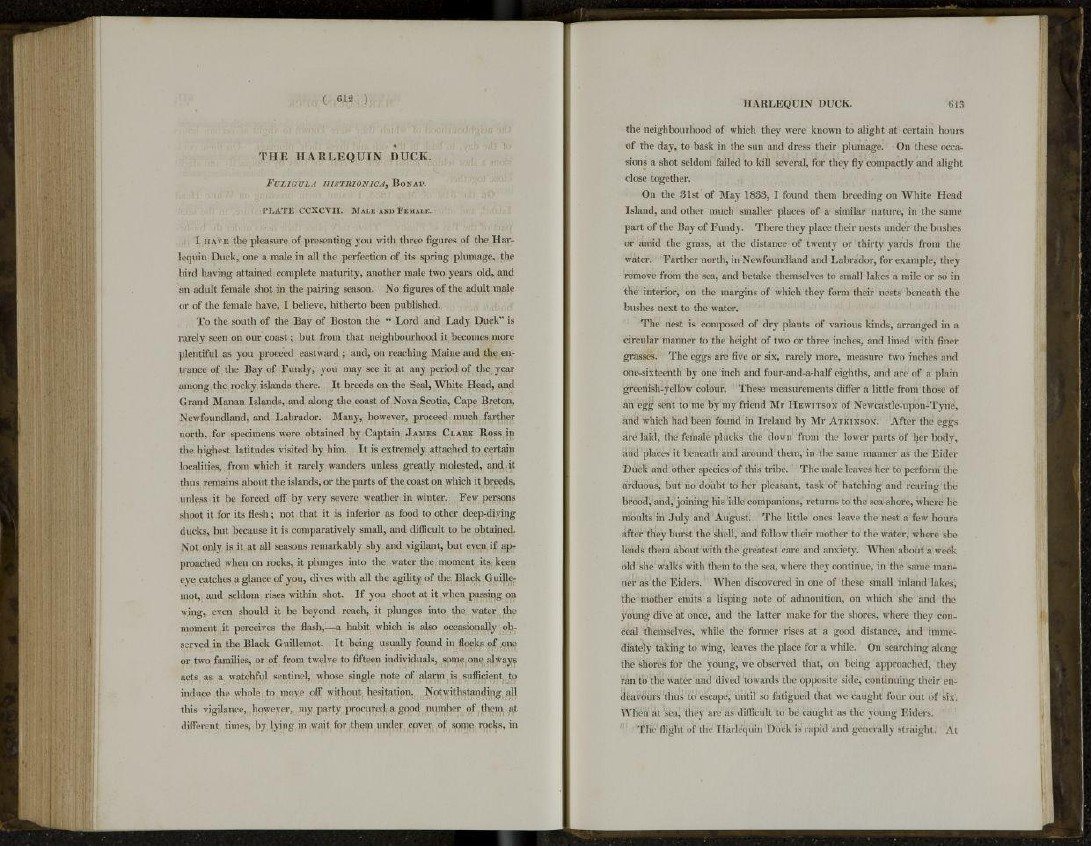
( 612 )
THE HARLEQUIN DUCK.
FULJGULA HISTRIONICA, BoNAP.
P L A T E C C X C V I I . MALE AND FEMALE.
1 H A V E the pleasure of presenting you with three figures of the Harlequin
Duck, one a male in all the perfection of its spring plumage, the
bird having attained complete maturity, another male two years old, and
an adult female shot in the pairing season. No figures of the adult male
or of the female have, I believe, hitherto been published.
T o the south of the Bay of Boston the " Lord and Lady Duck1' is
rarely seen on our coast; but from that neighbourhood it becomes more
plentiful as you proceed eastward; and, on reaching Maine and the entrance
of the Bay of Fundy, you may see it at any period of the year
among the rocky islands there. It breeds on the Seal, White Head, and
Grand Manan Islands, and along the coast of Nova Scotia, Cape Breton,
Newfoundland, and Labrador. Many, however, proceed much farther
north, for specimens were obtained by Captain JAMES CLARK Ross in
the highest latitudes visited by him. It is extremely attached to certain
localities, from which it rarely wanders unless greatly molested, and it
thus remains about the islands, or the parts of the coast on which it breeds,
unless it be forced off by very severe weather in winter. Few persons
shoot it for its flesh; not that it is inferior as food to other deep-diving
ducks, but because it is comparatively small, and difficult to be obtained.
Not only is it at all seasons remarkably shy and vigilant, but even if approached
when on rocks, it plunges into the water the moment its keen
eye catches a glance of you, dives with all the agility of the Black Guillemot,
and seldom rises within shot. If you shoot at it when passing on
wing, even should it be beyond reach, it plunges into the water the
moment it perceives the flash,—a habit which is also occasionally observed
in the Black Guillemot. It being usually found in flocks of one
or two families, or of from twelve to fifteen individuals, some one always
acts as a watchful sentinel, whose single note of alarm is sufficient to
induce the whole to move off without hesitation. Notwithstanding all
this vigilance, however, my party procured a good number of them at
different times, by lying in wait for them under cover of some rocks, in
HARLEQUIN DUCK.
the neighbourhood of which they were known to alight at certain hours
of the day, to bask in the sun and dress their plumage. On these occasions
a shot seldom failed to kill several, for they fly compactly and alight
close together.
On the .31st of May 1833, I found them breeding on White Head
Island, and other much smaller places of a similar nature, in the same
part of the Bay of Fundy. There they place their nests under the bushes
or amid the grass, at the distance of twenty or thirty yards from the
water. Farther north, in Newfoundland and Labrador, for example, they
remove from the sea, and betake themselves to small lakes a mile or so in
the interior, on the margins of which they form their nests beneath the
bushes next to the water.
The nest is composed of dry plants of various kinds, arranged in a
circular manner to the height of two or three inches, and lined with finer
grasses. The eggs are five or six, rarely more, measure two inches and
one-sixteenth by one inch and four-and-a-half eighths, and are of a plain
greenish-yellow colour. These measurements differ a little from those of
an egg sent to me by my friend Mr HEWITSON of Newcastle-upon-Tyne,
ana which had been found in Ireland by Mr ATKINSON. After the eggs
are laid, the female plucks the down from the lower parts of her bodv,
and places it beneath and around them, in the same manner as the Eider
Duck and other species of this tribe. The male leaves her to perform the
arduous, but no doubt to her pleasant, task of hatching and rearing the
brood, and, joining his idle companions, returns to the sea-shore, where he
moults in July and August. The little ones leave the nest a few hours
after they burst the shell, and follow their mother to the water, where she
leads them about with the greatest care and anxiety. When about a week
old she walks with them to the sea, where they continue, in the same manner
as the Eiders. When discovered in one of these small inland lakes,
the mother emits a lisping note of admonition, on which she and the
young dive at once, and the latter make for the shores, where they conceal
themselves, while the former rises at a good distance, and immediately
taking to wing, leaves the place for a while. On searching along
the shores for the young, we observed that, on being approached, they
ran to the water and dived towards the opposite side, continuing their endeavours
thus to escape, until so fatigued that we caught four out of six.
When at sea, they are as difficult to be caught as the young Eiders.
The flight of the Harlequin Duck is rapid and generally straight. At